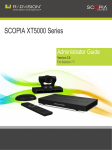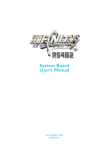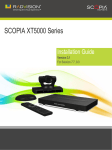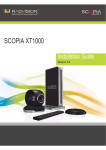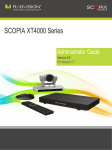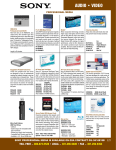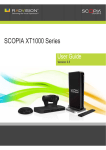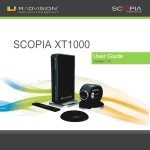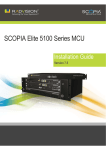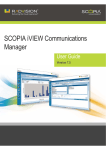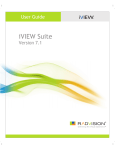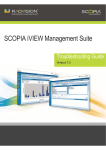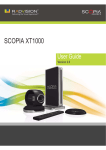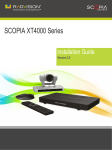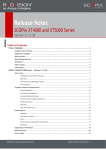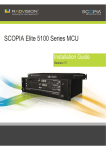Download RADVision Scopia XT5000 Series User guide
Transcript
SCOPIA XT5000 Series User Guide Version 3.0 © 2000-2012 RADVISION Ltd. All intellectual property rights in this publication are owned by RADVISION Ltd and are protected by United States copyright laws, other applicable copyright laws and international treaty provisions. RADVISION Ltd retains all rights not expressly granted. All product and company names herein may be trademarks of their registered owners. This publication is RADVISION confidential. No part of this publication may be reproduced in any form whatsoever or used to make any derivative work without prior written approval by RADVISION Ltd. No representation of warranties for fitness for any purpose other than what is specifically mentioned in this guide is made either by RADVISION Ltd or its agents. RADVISION Ltd reserves the right to revise this publication and make changes without obligation to notify any person of such revisions or changes. RADVISION Ltd may make improvements or changes in the product(s) and/or the program(s) described in this documentation at any time. If there is any software on removable media described in this publication, it is furnished under a license agreement included with the product as a separate document. If you are unable to locate a copy, please contact RADVISION Ltd and a copy will be provided to you. Unless otherwise indicated, RADVISION registered trademarks are registered in the United States and other territories. All registered trademarks recognized. For further information contact RADVISION or your local distributor or reseller. User Guide for SCOPIA XT5000 Series Version 3.0, February 2012 http://www.radvision.com RADVISION | User Guide for SCOPIA XT5000 Series Version 3.0 1 Table of Contents 1 SCOPIA XT Series Remote Control 2 About the SCOPIA XT Series About Securing Your Calls and Videoconferences....................................................... 5 3 Getting Started System Installation and Product Activation.............................................................. 6 Accessing the Main Menu ................................................................................... 7 Performing Basic Configuration............................................................................ 8 Setting the System Name and Language-related Settings ....................................... 9 Adjusting the Image Position....................................................................... 10 Configuring Network Settings ...................................................................... 12 Configuring Gatekeeper Settings .................................................................. 13 Setting the Interface Language.......................................................................... 14 Activating the Screen Saver.............................................................................. 14 Entering Alphanumeric Characters...................................................................... 15 Pairing a XT Remote Control Unit with a XT Codec Unit ............................................ 15 Restoring Default User Settings.......................................................................... 17 Viewing System Information ............................................................................. 17 4 Tailoring Your User Experience Enabling Automatic Answering .......................................................................... 19 RADVISION | User Guide for SCOPIA XT5000 Series Version 3.0 Table of Contents| i Enabling Call Disconnection Confirmation ............................................................. 20 Configuring the SCOPIA XT Series to Block Incoming Calls by Default............................. 21 Configuring the SCOPIA XT Series to Block Its Video Input by Default ............................ 22 Configuring the SCOPIA XT Series to Enter the Local Presentation Mode Automatically ....... 23 Setting the Monitor Resolution........................................................................... 24 5 Preparing for a Video Call or Videoconference Storing a Camera Position ................................................................................ 25 Connecting the Computer ................................................................................ 26 Selecting the Computer Display Resolution............................................................ 27 What You Should Know About Participating in a Video Call ......................................... 28 6 Making Calls Making a Call................................................................................................ 29 Dialing a New Number............................................................................... 29 Redialing the Number ............................................................................... 30 Dialing from the Phonebook ........................................................................ 31 Answering a Video Call .................................................................................... 31 Ending a Call ................................................................................................ 32 7 Managing Calls and Videoconferences Managing the Video ........................................................................................ 33 Controlling the Camera ............................................................................. 33 Positioning the Local and Remote Cameras ................................................ 34 Recalling a Camera Position .................................................................. 34 How to Change the Video Layout in a Call ....................................................... 35 About Video Layouts in the SCOPIA XT Series Using One Monitor ...................... 35 About Video Layouts in the SCOPIA XT Series Using Two Monitors ..................... 37 Changing the Video Layout During a Video Call ........................................... 39 Sharing Content ...................................................................................... 40 Sharing Content in the Local Conference Room ........................................... 40 Sharing Content during a Call ................................................................ 41 Blocking Video From the SCOPIA XT Series....................................................... 42 RADVISION | User Guide for SCOPIA XT5000 Series Version 3.0 Table of Contents| ii Managing the Audio ........................................................................................ 43 Adjusting the System Volume ...................................................................... 43 Adjusting the Ringing Volume ...................................................................... 44 Muting the Microphone Pod......................................................................... 44 Blocking Incoming Calls ................................................................................... 45 Managing the Phonebook ................................................................................. 45 Adding a Contact to the Phonebook............................................................... 45 Searching for a Contact in the Phonebook ....................................................... 47 Modifying a Contact in the Phonebook............................................................ 47 Deleting a Contact from the Phonebook.......................................................... 48 RADVISION | User Guide for SCOPIA XT5000 Series Version 3.0 Table of Contents| iii 1 SCOPIA XT Series Remote Control This section explains function of the SCOPIA XT Series Remote Control keys. Figure 1-1 The upper part of the XT Remote Control Unit RADVISION | User Guide for SCOPIA XT5000 Series Version 3.0 SCOPIA XT Series Remote Control | 1 Figure 1-2 The middle part of the XT Remote Control Unit Figure 1-3 The lower part of the XT Remote Control Unit RADVISION | User Guide for SCOPIA XT5000 Series Version 3.0 SCOPIA XT Series Remote Control | 2 2 About the SCOPIA XT Series The SCOPIA XT Series incorporates the latest state-of-the-art video technology for room high definition (HD) conferencing, including support for dual stream HD video, high quality data sharing, high quality full band audio and a high capacity embedded MCU (selected models). The SCOPIA XT Series covers a number of different models: • SCOPIA XT1000 Piccolo Experience cost-effective true HD 720p videoconferencing at 30 frames per second (fps) with the impressive price-performance design of the SCOPIA XT1000 Piccolo. The included wide angle Pan-Tilt-Zoom (PTZ) camera captures an entire group in the conference room, while 5x zoom offers focus on individuals and details. The SCOPIA XT1000 Piccolo supports high-resolution PC data sharing at 30fps, thus allowing presentations and video clips to be shared with no quality loss. The SCOPIA XT1000 Piccolo provides full band audio encoding to ensure high-clarity audio transmission with no loss of quality. The 3-way Microphone Pod uses state-of-the-art technology to focus on the speaker’s voice signal while filtering out the background noise. The ability to daisy-chain a second microphone provides unparalleled large room coverage. • SCOPIA XT1000 and SCOPIA XT1200 The SCOPIA XT1000 and SCOPIA XT1200 share the same XT Codec Unit, but the SCOPIA XT1200 has a camera with higher quality optics. Both models support two full HD 1080p video streams as standard, delivered at 30fps. Both cameras are PTZ with 10x optical zoom for more powerful viewing options. The SCOPIA XT1200’s camera also features an additional 4x digital zoom. The second video stream can be used with an additional 1080p camera for visual coverage or with a PC for data sharing, at 1080p delivered at 30fps. Both also come with the same 3-way Microphone Pods for superb signal to noise ratios. • SCOPIA XT Telepresence Experience the immersive feeling of telepresence using the SCOPIA XT Telepresence Platform, which incorporates state-of-the-art technology with support for full HD 1080p video in each of the three cameras, 20 kHz full band audio with 48 kHz sampling rate and 1080p 30fps PC data sharing for an immersive life-like experience. • SCOPIA XT5000 Series The SCOPIA XT5000 Series is the latest product of the SCOPIA XT Series which sets the standard for an exceptional conferencing experience: HD 1080p with 48 kHz sampling rate and 60fps for live video and PC data sharing. The SCOPIA XT5000 is designed for an end user and is very easy to setup and control. For an even better experience, the SCOPIA XT5000 Series is enabled for Multi-Touch control via the Apple iPad. RADVISION | User Guide for SCOPIA XT5000 Series Version 3.0 About the SCOPIA XT Series | 3 The SCOPIA XT1000 and SCOPIA XT1200 can also host HD continuous presence videoconferences with their built-in MCU. Depending on your deployment, you can host videoconferences either with other H.323 endpoints, or you can extend participants to include both H.323 endpoints and SCOPIA Desktop Clients: • SCOPIA XT Series MCU Edition This features your chosen XT Series model with the ability to host videoconferences only with standard H.323 endpoints. You can choose a license of up to 4 or 9 participants. • SCOPIA XT Series SMB Edition This edition features your chosen XT Series model with the ability to host videoconferences with both H.323 endpoints and/or SCOPIA Desktop Clients. It includes the software of the SCOPIA XT Desktop Server which must be deployed in the DMZ. In this deployment, you can choose a license of up to 4 or 9 participants. Table 2-1 on page 5 summarizes the differences between each of the models in the SCOPIA XT Series. RADVISION | User Guide for SCOPIA XT5000 Series Version 3.0 About the SCOPIA XT Series | 4 Table 2-1 Differences in features for models in the SCOPIA XT Series Feature SCOPIA XT1000 Piccolo SCOPIA XT1000 and SCOPIA XT1200 SCOPIA XT Telepresence SCOPIA XT5000 Series Maximum HD resolution 720p 1080p 3 x 1080p 1080p Frames Per Second 30fps (fps) 30fps, 720p at 60fps 30fps, or 720p at (incoming only on 60fps XT1000) 60fps, both at 720p and 1080p Hosting videoconferences (embedded MCU) No Optional No Optional (from the next version) Optical zoom 5x 10x 10x 10x Dual video 720p at 30fps 1080p at 30fps 1080p at 30fps (x 3 1080p60/1080p60 for transmission) Scalable video coding No No No Yes High Profile H.264 No No No Yes 3-way Microphone Yes Pods Yes Yes Yes About Securing Your Calls and Videoconferences The system can manage secure videoconference sessions via encrypted connections, in both point-to-point and multipoint sessions. The multipoint videoconference supports up to three remote encrypted participants. If your system administrator enabled encryption in your system and your call is secured, an icon showing a padlock appears on your display. RADVISION | User Guide for SCOPIA XT5000 Series Version 3.0 About the SCOPIA XT Series | 5 3 Getting Started Congratulations on your purchase of the SCOPIA XT Series. To get started with video calls and videoconferences, activate the product and use the quick setup wizard to configure the basic settings of the unit. • System Installation and Product Activation................................................. page 6 • Accessing the Main Menu ...................................................................... page 7 • Performing Basic Configuration............................................................... page 8 • Setting the Interface Language .............................................................. page 14 • Activating the Screen Saver .................................................................. page 14 • Entering Alphanumeric Characters.......................................................... page 15 • Pairing a XT Remote Control Unit with a XT Codec Unit ................................ page 15 • Restoring Default User Settings.............................................................. page 17 • Viewing System Information.................................................................. page 17 System Installation and Product Activation For installation and product activation of the SCOPIA XT Series, consult the documentation enclosed in the delivery package: • SCOPIA XT5000 Series Quick Setup Guide • SCOPIA XT5000 Series Safety Instructions leaflet The Quick Setup section covered in the Quick Setup Guide explains the minimal required setting necessary to enjoy a proper working of the system. Your system administrator may have customized certain features described in this guide to suit the environment of your company. Please ask your service administrator for details on your system’s customization. Once you have completed the installation, you are ready to use the system’s menus. RADVISION | User Guide for SCOPIA XT5000 Series Version 3.0 Getting Started | 6 Accessing the Main Menu You access the main functions through the Main menu: • Call—making audio and video calls • Contacts—access to the phonebook • Present—start sharing content • Control camera—adjust camera position • Configure—perform basic configuration and check the system status You navigate SCOPIA XT Series menus using arrow keys and pressing the OK key on the XT Remote Control Unit. Before You Begin Verify that the power supply of the XT Codec Unit is connected. Procedure Step 1 Step 2 Step 3 Step 4 Step 5 Turn on the TV monitors. Make sure the XT Remote Control Unit has batteries installed. Verify that the LED on the front panel of the XT Codec Unit is blinking. Turn on the XT Codec Unit by pressing the On/Off key on the XT Remote Control Unit. The system home page appears on the monitors. If you access the system for the first time, the Quick Setup wizard is displayed; otherwise the Main menu appears. RADVISION | User Guide for SCOPIA XT5000 Series Version 3.0 Getting Started | 7 Figure 3-1 Main menu Step 6 Select one of the options using the arrow keys of the XT Remote Control Unit. Performing Basic Configuration During this configuration you define some basic settings for your SCOPIA XT Series, like user interface language, the system name, and network settings. Notice that your system administrator might already have set these parameters for you. In addition to fresh installations, you need to use the quick setup wizard after restoring default settings and re-installing software. The quick setup wizard guides you through these basic configuration tasks: • Setting the System Name and Language-related Settings ................................ page 9 • Adjusting the Image Position ................................................................. page 10 • Configuring Network Settings ................................................................ page 12 • Configuring Gatekeeper Settings ............................................................ page 13 The tasks appear in this section in the order they are presented in the quick setup wizard. The quick setup wizard automatically appears when you turn the XT Codec Unit on for the first time. If the quick setup wizard is not displayed automatically, select Configure on the Main Menu page and then select Quick setup. RADVISION | User Guide for SCOPIA XT5000 Series Version 3.0 Getting Started | 8 Setting the System Name and Language-related Settings This page allows you to select the name of your XT Codec Unit. The name is displayed on the monitors participating in the videoconference call (for example: Hong-Kong, or 9th-Floor-Room, or NY-Office). You can also configure the fields required for setting up calls. You can also select the country in which the system is located and the language in which the system menus are displayed. Before You Begin Turn on the SCOPIA XT Series unit to start the quick setup wizard. or If the quick setup wizard is not displayed automatically, in the Main menu page select Configure > Quick Setup. Procedure Step 1 Enter the name of the SCOPIA XT Series in the System name field using the alphanumeric keys of the XT Remote Control Unit. By default you can enter letters before you can enter digits. To change the input method refer to “Entering Alphanumeric Characters” on page 15. Figure 3-2 Setting Country and Language RADVISION | User Guide for SCOPIA XT5000 Series Version 3.0 Getting Started | 9 Step 2 Select the required country from the Country list using the arrow keys and press . The system menu and the Language field automatically change to the language used in the selected country. Step 3 Step 4 If you want to change the language of the system menus, select the required language from the the Language list and press . The list of languages is displayed. Scroll to the preferred language and press . Select Next to continue the basic configuration. Adjusting the Image Position If your monitor does not center the image correctly, perform this procedure. Before You Begin This procedure is performed as part of the basic configuration after “Setting the System Name and Language-related Settings” on page 9. Procedure Step 1 Examine the image on the monitor to decide if you need to adjust the image position. Triangles in the top left corner and bottom right corner must be fully visible. If the image is centered correctly, skip this procedure and select Next. Figure 3-3 Examining the image position RADVISION | User Guide for SCOPIA XT5000 Series Version 3.0 Getting Started | 10 Step 2 Press 1 to align the top left corner. Figure 3-4 Adjusting the image position Step 3 Step 4 Step 5 Step 6 Use the arrow keys on the XT Remote Control Unit to position the image, and then press OK. Press 2 to align the bottom right corner. Use the arrow keys on the XT Remote Control Unit to position the image, and then press OK. Select Next. RADVISION | User Guide for SCOPIA XT5000 Series Version 3.0 Getting Started | 11 Configuring Network Settings This page allows you to setup the GLAN1 settings and the IP address the system uses for placing a call. Consult with your network administrator to configure these fields. Before You Begin This procedure is performed as part of the basic configuration after “Adjusting the Image Position” on page 10. Procedure Step 1 Press and scroll to Yes from the Automatic IP address list. Figure 3-5 Defining IP Settings Step 2 Step 3 Configure the IP addresses. Press Close to exit the quick setup wizard. RADVISION | User Guide for SCOPIA XT5000 Series Version 3.0 Getting Started | 12 Configuring Gatekeeper Settings If your SCOPIA XT Series works in conjunction with a gatekeeper, configure gatekeeper-related settings. Use this section to configure gatekeeper settings. This procedure completes the basic system configuration. Before You Begin This procedure is performed as part of the basic configuration after “Configuring Network Settings” on page 12. Procedure Step 1 Set the Enabled list to Yes. Figure 3-6 XT Codec Unit Step 2 Step 3 Step 4 Step 5 Set the Mode list to Manual. Enter the IP address of the gatekeeper in the IP address field. Enter the H.323 number required to dial the XT Codec Unit in the Number H.323 field. Select Done. The basic configuration of your SCOPIA XT Series is complete. RADVISION | User Guide for SCOPIA XT5000 Series Version 3.0 Getting Started | 13 Setting the Interface Language You may set the interface language in the Quick Setup Wizard or from the SCOPIA XT Series web interface. Procedure Step 1 Step 2 Access the SCOPIA XT Series web interface. Select the User settings tab. The User Preferences page opens. Figure 3-7 User Preferences page Step 3 Step 4 Select the required language from the Language list. Select Save. Activating the Screen Saver The screen saver helps to protect your monitor from burn-in without switching it off. Your administrator may have configured the screen saver to start automatically when SCOPIA XT Series is not used for some time. You can activate the screen saver at any moment. RADVISION | User Guide for SCOPIA XT5000 Series Version 3.0 Getting Started | 14 Procedure Step 1 Press the On/Off key on the XT Remote Control Unit. The confirmation message appears on the screen. Step 2 Select No. The screen saver is activated. Entering Alphanumeric Characters Use the XT Remote Control Unit keypad to enter letters and digits. The default input method is abc1: you must press the alphanumeric button repeatedly before entering a digit. To enter text in the XT Series interface, scroll to the input field and enter the required characters. You can also select another input method that best suits the type of information you want to enter in the input field. Press while the cursor is in the input field. The input methods are displayed. Press repeatedly to select one of these methods: • Typing digits before typing letters: 1abc for lowcase letters and 1ABC for uppercase letters. • Typing letters before typing digits: abc1 for lowcase letters and ABC1 for uppercase letters. • Typing only digits (123). Pairing a XT Remote Control Unit with a XT Codec Unit Multiple XT Codec Units can be set up in the conference room and controlled with different XT Remote Control Units. You can dedicate your XT Remote Control Unit to monitor one or more XT Codec Units of your choice by configuring the same numeric code in your XT Remote Control Unit and the system software. An XT Remote Control Unit is configured with code 11 by default. Before You Begin Decide what numeric code you want to use for your monitor and the XT Codec Unit. Procedure Step 1 Step 2 Access the SCOPIA XT Series web interface. Select the User settings tab. RADVISION | User Guide for SCOPIA XT5000 Series Version 3.0 Getting Started | 15 Step 3 Select General under Preferences. Figure 3-8 Setting the XT Remote Control Unit Code Step 4 Step 5 Step 6 Enter the code in the Remote control code field. Select Save. On the XT Remote Control Unit, press and simultaneously. The On/Off key on the XT Remote Control Unit turns red. Step 7 Using the keypad, type the number you just entered in the Remote control code field. Note: Step 8 You must always use two digits for a code. For example, to set the code to “1”, enter “01”. Select Finish. The code of the XT Remote Control Unit is changed and the Remote Control Remote Control code appear at the top of the screen. RADVISION | User Guide for SCOPIA XT5000 Series Version 3.0 icon and the new Getting Started | 16 Restoring Default User Settings You can change the default settings of the system to adapt them to your work requirements. This procedure explains how to restore the default settings if necessary. You can restore the default settings at any time. Procedure Step 1 Step 2 Step 3 Step 4 Step 5 Access the SCOPIA XT Series web interface. Select the User Settings tab. Select Load default values. Select General. Select the Restore default button. The default settings are restored. Viewing System Information You can view the following system information if your system is not currently in a call: • software version • user code • IP addresses • serial number Note: If you need the system serial number, you can also look on the label at the back of the XT Codec Unit. RADVISION | User Guide for SCOPIA XT5000 Series Version 3.0 Getting Started | 17 Procedure Step 1 From the Main Menu, select Configure using the XT Remote Control Unit. Figure 3-9 The Main Menu Step 2 Select System Status. The system information is displayed. RADVISION | User Guide for SCOPIA XT5000 Series Version 3.0 Getting Started | 18 4 Tailoring Your User Experience This section explains how to configure your SCOPIA XT Series so that your user experience is optimal. All configurations in this section are optional; you can perform them in any order and at any time. • Enabling Automatic Answering............................................................... page 19 • Enabling Call Disconnection Confirmation ................................................. page 20 • Configuring the SCOPIA XT Series to Block Incoming Calls by Default................. page 21 • Configuring the SCOPIA XT Series to Block Its Video Input by Default ................ page 22 • Configuring the SCOPIA XT Series to Enter the Local Presentation Mode Automatically..... page 23 • Setting the Monitor Resolution .............................................................. page 24 Enabling Automatic Answering You can enable automatic answering to an incoming call. You may select among a number of settings: Yes always, Never, Yes if not already in a call. You can also set the number of alert rings the system plays until you answer the call. Procedure Step 1 Step 2 Access the SCOPIA XT Series web interface. Select the User Settings tab. RADVISION | User Guide for SCOPIA XT5000 Series Version 3.0 Tailoring Your User Experience | 19 Step 3 Select General under Call-Answer. Figure 4-1 The call-answer settings Step 4 Select the required option from the Automatic answer list: • Yes always: this setting enables automatic answer to an incoming call. The system will not prompt you to accept a call if the display shows the Home page. • Never: this setting disables automatic answer to an incoming call. The system will always prompt you to accept a call. • Yes if not already in a call: this setting enables automatic answer only if the system is not in a call. If the system is in a call, it displays a notification about another incoming call, allowing you to accept it. When you accept an incoming call already being in a call, the embedded MCU is activated. Step 5 Step 6 (Optional) Enter the number of rings in the After Num. Rings list to specify after how many rings the system accepts a call. This option is relevant only if automatic answering is enabled. Select Save. Enabling Call Disconnection Confirmation You can configure the system to request a confirmation when a call is disconnected. Procedure Step 1 Step 2 Access the SCOPIA XT Series web interface. Select the User Settings tab. RADVISION | User Guide for SCOPIA XT5000 Series Version 3.0 Tailoring Your User Experience | 20 Step 3 Select General under Call-Answer. Figure 4-2 The call-answer settings Step 4 Step 5 Set Confirm disconnection to Yes. Select Save. Configuring the SCOPIA XT Series to Block Incoming Calls by Default You can configure the SCOPIA XT Series to block all incoming calls by enabling the Use Do Not Disturb (DND) feature if you do not want to answer incoming calls. When the Do Not Disturb feature is enabled: • The system blocks notifications of incoming calls. • The icon appears in the system information area of the monitor display. • When the remote terminal calls, the system informs it that the call is rejected. The calling terminal is automatically disconnected. You can also block incoming calls manually as described in Blocking Incoming Calls page 45. Even when the system is set to blocking incoming calls by default, you can temporarily disable the DND feature by holding the Privacy key on the XT Remote Control Unit. Procedure Step 1 Step 2 Access the SCOPIA XT Series web interface. Select the User Settings tab. RADVISION | User Guide for SCOPIA XT5000 Series Version 3.0 Tailoring Your User Experience | 21 Step 3 Select General under Call-Answer. Figure 4-3 The call-answer settings Step 4 Step 5 Set Do Not Disturb to Yes. Select Save. Configuring the SCOPIA XT Series to Block Its Video Input by Default You can configure the SCOPIA XT Series to block video transmission from your local endpoint at the start of each call. When configured in this way, the system sends a pre-defined image to the remote endpoint. The icon appears on your display, indicating that the remote endpoint no longer receives video from your local endpoint. Procedure Step 1 Step 2 Access the SCOPIA XT Series web interface. Select the User Settings tab. RADVISION | User Guide for SCOPIA XT5000 Series Version 3.0 Tailoring Your User Experience | 22 Step 3 Select General under Call-Answer. Figure 4-4 The call-answer settings Step 4 Step 5 Set Video Privacy to Yes. Select Save. Configuring the SCOPIA XT Series to Enter the Local Presentation Mode Automatically Local presentation mode is an XT Series feature that allows to easily connect a PC laptop to the DVI connector of the XT Codec Unit for having a presentation or any other PC content immediately available on the monitors. When in the local presentation mode, the system does not accept incoming calls automatically. When an incoming call is received, the local presentation mode is suspended. The original video source and graphics are restored, and system displays the prompt allowing you to choose how to handle the call (accept/reject/do not disturb). You can configure your XT Series so that it enters the local presentation mode automatically. When configured so, the system starts presenting the moment you connect a PC to the DVI connector on the XT Codec Unit if there is no active call. If the PC resolution is not supported, the system suggests the maximum supported resolution for the PC/laptop:1440x1080p or 1920x1080p. When accessing the local presentation mode, the current selection of the live camera is saved; the video input switches to DVI and the audio settings associated to DVI are automatically used. You can also enter the local presentation mode manually by pressing the Presentation button on the XT Remote Control Unit. RADVISION | User Guide for SCOPIA XT5000 Series Version 3.0 Tailoring Your User Experience | 23 Procedure Step 1 Step 2 Step 3 Access the SCOPIA XT Series web interface. Select the User Settings tab. Select General under User preferences. Figure 4-5 The user preference settings Step 4 Step 5 Select Auto from the Local presentation mode list. Step 6 Set the required setting in the Keep presentation aspect ratio list: Set Show warnings to Yes if you want the system to display a warning when the local presentation mode is activated. • • Yes—to keep the original presentation ratio. No—to display the presentation in 4:3 format so that it fills all the monitor. Setting the Monitor Resolution The rear panel of the XT Codec Unit features 2 HD outputs for connecting a main and auxiliary screen. For cabling, see the cabling diagram in the Quick Setup Guide. Your system administrator must configure the system for correct video resolution. When you are not in a call, you can set the refresh frequency of the monitor display: • Set to 50 Hz by pressing • Set to 60 Hz by pressing RADVISION | User Guide for SCOPIA XT5000 Series Version 3.0 then 5. then 6. Tailoring Your User Experience | 24 5 Preparing for a Video Call or Videoconference This section gives recommendations on how to prepare your meeting room and your SCOPIA XT Series for a video call or videoconference: • Storing a Camera Position .................................................................... • Connecting the Computer .................................................................... • Selecting the Computer Display Resolution................................................ • What You Should Know About Participating in a Video Call ............................ page 25 page 26 page 27 page 28 In addition to performing these tasks, you may need to do the following: • Verify that all lights are on in your meeting room. • If you need an additional HD camera or recorder, make sure it is correctly connected as described in Installation Guide for SCOPIA XT Series. Storing a Camera Position Move the camera to the position showing the best frame of a location or a video source. You can make this adjustment before or during a call. Then store the position in your system. When you set up a videoconference, you can quickly recall the stored position and thus facilitate the organization of the call. You can number and store up to 122 positions. When you recall the stored number using the XT Remote Control Unit, the camera moves to the preset position. For operational information on how to recall a stored camera position, refer to “Recalling a Camera Position” on page 34. Procedure Step 1 Move the camera as described in Positioning the Local and Remote Cameras page 34 and adjust to the desired position. Step 2 Press the Preset key on the XT Remote Control Unit, and enter a number for the current position. A message confirming the stored position appears on the display. RADVISION | User Guide for SCOPIA XT5000 Series Version 3.0 Preparing for a Video Call or Videoconference | 25 Connecting the Computer You need a computer to share a presentation during a call. This procedure describes how to connect computers that are equipped with a DVI out or VGA out connector. The XT Codec Unit supports these DVI input formats: 1920 x 1080, 1440 x 900 (WSXGA), 1280 x 1024 (SXGA), 1280 x 720, 1280 x 768 (WXGA), 1024 x 768 (XGA), 800 x 600 (SVGA), 640 x 480 (VGA). Procedure Step 1 Caution Connect your computer to the XT Codec Unit: Make sure all units are switched off whenever connecting or disconnecting devices. • For computers and laptops with a DVI out connector, connect the DVI cable to the DVI-I socket of the XT Codec Unit and connect the other end of the cable to the computer. Figure 5-1 Connecting a computer to SCOPIA XT5000 Series • For computers with a VGA output connector, use a DVI to VGA adapter. a. Connect the DVI-VGA adapter to the DVI-IN socket of the XT Codec Unit. b. Connect a VGA cable to the adapter. This cable is not supplied with the system. RADVISION | User Guide for SCOPIA XT5000 Series Version 3.0 Preparing for a Video Call or Videoconference | 26 c. Connect the VGA cable to the PC/Laptop VGA out socket. Step 2 Connect the computer audio to the XT Codec Unit. • • Since audio input is not included in the DVI-I port to XT Codec Unit connection, establish a separate audio connection from the computer’s audio output port into the optical audio input port of the XT Codec Unit. You can also use an external analog-to-digital converter if necessary. Selecting the Computer Display Resolution Configure the computer display to one of the supported picture resolutions and refresh frequencies. Procedure Step 1 Step 2 Step 3 Right-click on your computer desktop. The Display Properties page appears. Select Settings. Select one of the relevant resolution and refresh frequencies. Table 5-1 Note: Resolution and Refresh Frequencies Name Resolution Refresh Frequency (Hz) 1080p 1920x1080 60 1776x1000 60 900p 1600x900 60 WSXGA 1440x900 60 SXGA 1280x1024 60 WXGA 1280x768 60 720P 1280x720 60 XGA 1024x768 60 1024x600 60 SVGA 800x600 60 VGA 640x480 60 If you connect a camera to the DVI-I input, the system will manage it as PC content. RADVISION | User Guide for SCOPIA XT5000 Series Version 3.0 Preparing for a Video Call or Videoconference | 27 What You Should Know About Participating in a Video Call There are several general recommendations you should follow to optimize your videoconferencing experience. We recommend that you read this section before participating in a videoconference for the first time. • If you are using a portable computer during a meeting, do not place it too close to the microphone pods. Noise produced by the computer cooling system may be increased by the microphones and aggravate the quality of audio in the meeting. • Use natural gestures as in a real meeting. • Place chairs so that you and other participants appear in the middle of the monitors. Verify that the background does not take up too much space on the monitors. • Place the Microphone Pod on the table in front of people. • Use 2 Microphone Pods in case of large conference tables. • Do not place papers or other objects in front of the Microphone Pod. • Do not rustle papers or tap on the conference table or the Microphone Pod. • Mute the Microphone Pod before moving it. • Speak in a normal voice, not louder or softer. • Avoid using your cellular phones during your meeting to avoid EMI (electromagnetic interference). RADVISION | User Guide for SCOPIA XT5000 Series Version 3.0 Preparing for a Video Call or Videoconference | 28 6 Making Calls You can make a video call on the SCOPIA XT Series in several ways. This chapter outlines how to dial to other endpoints in different modes, and how to answer and terminate a call. • Making a Call.................................................................................... • Answering a Video Call........................................................................ • Ending a Call .................................................................................... page 29 • Dialing a New Number......................................................................... • Redialing the Number ......................................................................... • Dialing from the Phonebook.................................................................. page 29 page 31 page 32 Making a Call page 30 page 31 Dialing a New Number Perform the procedure in this section to dial a number for the first time. You can change these default call settings: • Call protocol—Choose the protocol: H.323, SIP or ISDN. • Call rate—By default, the system uses the maximum available bandwidth. • Call type—Choose the call type: Audio-Video or Audio. After you dial a number, it is listed in the list of dialed numbers. If you manage your SCOPIA XT Series remotely using web interface, you can dial a number remotely by accessing the web interface and navigating to Make your call > Direct call > Basic options. Procedure Step 1 Step 2 Dial number using the XT Remote Control Unit. (Optional) To change the default call settings: a. Select the Advanced options button RADVISION | User Guide for SCOPIA XT5000 Series Version 3.0 . Making Calls | 29 Figure 6-1 Changing advanced call settings b. Select options using arrow keys on the XT Remote Control Unit and select necessary values using the OK key. Step 3 Press . Redialing the Number Once you dial a new number it is added to the list of dialed numbers; then you can select this number and dial it. The system allows you to store up to 25 recent calls. These icons appear next to a contact number or name: • • • — Received call — Dialled call — Missed call If you manage your SCOPIA XT Series remotely using web interface, you can redial the number remotely by accessing the web interface and navigating to Make your call> Recent calls. RADVISION | User Guide for SCOPIA XT5000 Series Version 3.0 Making Calls | 30 Figure 6-2 Redialing numbers from the SCOPIA XT5000 Series web interface Procedure Step 1 In the Main menu, select Calls. The Recent calls list appears. Step 2 Step 3 Select the relevant call using the arrow keys. Press Call. Dialing from the Phonebook If the endpoint you want to call is listed in your phonebook, you can call it without dialing its number. If you manage your SCOPIA XT Series remotely using web interface, you can redial a contact remotely by accessing the web interface and navigating to Make your call > Contacts. Procedure Step 1 Step 2 Step 3 Step 4 In the Main menu, select Directory. Enter the name of the contact or enter asterisk (*) to display all contacts. Select the contact you wish to dial. Press . Answering a Video Call You can answer calls manually or set the system to answering the call automatically. If you set your system to automatic answering, the endpoint answers after the predefined number of rings. RADVISION | User Guide for SCOPIA XT5000 Series Version 3.0 Making Calls | 31 If you set your system to manual answering, you can either accept or reject the incoming call. When there is an incoming call, the system displays a window with these options: • To accept the call, press Accept or on the XT Remote Control Unit. • To reject the call, select the Reject option on the screen by pressing the right arrow key and on the XT Remote Control Unit. • To reject the call and set the system to automatically reject all further incoming calls without asking any more, select the Do not disturb option on the screen by pressing the right arrow key twice and on the XT Remote Control Unit. For information about setting the system to answering calls automatically, see “Enabling Automatic Answering” on page 19. Ending a Call Procedure Step 1 Step 2 Press Press on the XT Remote Control Unit. to confirm, if your system is set to Confirm disconnection. RADVISION | User Guide for SCOPIA XT5000 Series Version 3.0 Making Calls | 32 7 Managing Calls and Videoconferences This chapter details the configurations you can make on your SCOPIA XT Series to control the way the video is displayed, to control the audio output and input, encryption support and managing contacts. • Managing the Video............................................................................ • Managing the Audio............................................................................ • Blocking Incoming Calls ....................................................................... • Managing the Phonebook ..................................................................... page 33 page 43 page 45 page 45 Managing the Video This section describes how you can control the camera settings, the monitor display settings, and how to share content from a computer to display a presentation or some other document. • Controlling the Camera ....................................................................... • How to Change the Video Layout in a Call................................................. • Sharing Content ................................................................................ • Blocking Video From the SCOPIA XT Series ................................................ page 33 page 35 page 40 page 42 Controlling the Camera This section describes how to configure the camera settings and define its default settings. • Positioning the Local and Remote Cameras ............................................... • Recalling a Camera Position.................................................................. RADVISION | User Guide for SCOPIA XT5000 Series Version 3.0 page 34 page 34 Managing Calls and Videoconferences | 33 Positioning the Local and Remote Cameras You can control the remote camera when the connection with the remote endpoint is established and the remote camera is configured to be remotely managed. Procedure Step 1 Step 2 Access the SCOPIA XT Series web interface. Select the Cameras tab. Figure 7-1 Positioning cameras Step 3 Step 4 Step 5 Step 6 Choose the camera you want to position by selecting Local or Remote. Position the camera by selecting arrow buttons under Move. If necessary, adjust the zoom by selecting the Plus and Minus buttons under Zoom. Choose the other camera and position it, if necessary. Recalling a Camera Position This feature helps you move the camera to your preferred position and facilitates setting up the videoconference. Just recall the preferred camera position you stored previously in the system, and the camera moves to the memorized position. For information about storing a camera position, see “Storing a Camera Position” on page 25. Procedure Step 1 Step 2 Press preset on the XT Remote Control Unit. Enter the number corresponding to the required preset position. RADVISION | User Guide for SCOPIA XT5000 Series Version 3.0 Managing Calls and Videoconferences | 34 How to Change the Video Layout in a Call A video layout is what windows appear and how they are arranged on the monitor. Video layouts of your XT Series depend on whether it uses one or two monitors. The layouts are preconfigured by the administrator so that a set of default layouts is available for you. You can change the video layouts on your XT Series during a call to optimize your videoconferencing experience. • About Video Layouts in the SCOPIA XT Series Using One Monitor ...................... page 35 • About Video Layouts in the SCOPIA XT Series Using Two Monitors..................... page 37 • Changing the Video Layout During a Video Call ........................................... page 39 About Video Layouts in the SCOPIA XT Series Using One Monitor You see the video and hear the audio on the connected monitor. Note: If you connect another monitor to the free HD socket and the monitor is configured to Auto by the Administrator, the additional monitor is automatically used to show local video or a presentation (local or remote). See the SCOPIA XT Series Installation Guide for information. When you’re not in a call, the monitor displays the system menus and the video taken by the local camera. In a call, the monitor can split the screen to show the system menus, video (remote, local) and presentation (remote, local) in different windows. You can arrange the monitor layout and content by using the PIP and Layout keys on the XT Remote Control Unit. Figure 7-2 on page 36 pictures the monitor default layout during a call. In this example, the display shows the remote video, presentation, and system menus. The overlapping image you see in the screen is called a PIP (Picture In Picture) view. The PIP view shows the remote presentation in the main part of the screen, and the remote video in the small image. If the remote terminal does not show any content, the display shows the remote video in the main part of the screen, and the local presentation in the small image. RADVISION | User Guide for SCOPIA XT5000 Series Version 3.0 Managing Calls and Videoconferences | 35 Figure 7-2 Showing the monitor in PIP view Figure 7-3 on page 36 depicts a PaP (Picture and Picture) view in which two images are presented side by side and at the same size. Figure 7-3 Showing the monitor in PaP view Figure 7-4 depicts a PoP (Picture out Picture) view in which two images of different size are presented side by side. RADVISION | User Guide for SCOPIA XT5000 Series Version 3.0 Managing Calls and Videoconferences | 36 Figure 7-4 Showing the monitor in PoP view You can use PIP, PaP or PoP views only if your system administrator has configured them in your XT Codec Unit. About Video Layouts in the SCOPIA XT Series Using Two Monitors When you’re not in a call, one monitor shows the system menus; both monitors display the video taken by the local camera. In a call, one monitor contains the system menus; the available video streams (local video, remote video, local or remote presentation) are distributed on the two monitors according to the selected monitor configuration. You can further arrange the monitor layouts and content by using Layout and PIP keys on the XT Remote Control Unit. Your system administrator configures the monitors to show one of these layouts when you are in a call: RADVISION | User Guide for SCOPIA XT5000 Series Version 3.0 Managing Calls and Videoconferences | 37 • Configuring to HD1 (Menu & Video Rx) + HD2 (Present). See Figure 7-5 on page 38. The main monitor (HD1) shows the system menus, the received video, and local video. The local video is in a small overlapping window, also called a PIP (Picture in Picture) view. The auxiliary monitor (HD2) shows the presentation (local or remote), if available. The audio is automatically enabled on HD1. This is the default configuration. Figure 7-5 Menu, received video, and local video on HD1 and presentation on HD2 • Configuring to HD1 (Menu & Present) + HD2 (Video Rx). See Figure 7-6 on page 38. HD1 shows the system menus, the presentation (local or remote) if available, and the local video in a small overlapping window. HD2 shows the received video. The audio is automatically enabled on HD1. Figure 7-6 Menu, presentation, and local video on HD1 and received video on HD2 • Configuring to HD1 (Present) + HD2 (Menu & Video Rx). See Figure 7-7 on page 39. HD1 shows the presentation (local or remote), if available. HD2 shows the system menus, the received video, and the local video in a small overlapping window. RADVISION | User Guide for SCOPIA XT5000 Series Version 3.0 Managing Calls and Videoconferences | 38 Figure 7-7 Presentation on HD1, and menu, received video, and local video on HD2 • Configuring to HD1 (Video Rx) + HD2 (Menu & Present). See Figure 7-8 on page 39. HD1 shows the received video. HD2 shows the system menus, the presentation (local or remote) if available, and the local camera image in a small overlapping window. Figure 7-8 Received video on HD1 and local video, presentation, and menu on HD2 Seeing two images side by side and at the same size in one monitor is called PaP (Picture and Picture) view. See Figure 7-3 on page 36 for a picture of the PaP view. You can use PIP or PaP views only if your system administrator has configured them in your XT Codec Unit. Changing the Video Layout During a Video Call During the call, you can change your monitor’s current layout to best serve your purpose. You can also change the default layout activated every time your XT Series is connected, disconnected or when content is shared. RADVISION | User Guide for SCOPIA XT5000 Series Version 3.0 Managing Calls and Videoconferences | 39 You can change the layout as follows: • To change the position of a PIP view on the monitor, show a PaP or PoP view, or display a full screen view of one of the images, press repeatedly. • When you are in PIP, Pap or PoP view, you can change its content by pressing • When you are in full presentation view, you can change its content by pressing repeatedly. repeatedly. System menus automatically disappear from the display after a few seconds in a call. You can also remove them manually by pressing . To bring back the system menus, press again or Back key again. Note: When there is no call, you can reset the monitors to the default configuration by pressing then 0 on the XT Remote Control Unit. and Sharing Content This section details how to share a presentation or any other file from a PC. Typically, a conference room can have one or two monitors. Depending on the conference room configuration, the presentation is shown either on the same monitor as the live remote video or on the monitor of its own. For more information see “About Video Layouts in the SCOPIA XT Series Using One Monitor” on page 35 and “About Video Layouts in the SCOPIA XT Series Using Two Monitors” on page 37. You can share content only in your local conference room or with all conference rooms and endpoints participating in a call. Local presentation mode is an SCOPIA XT Series feature that allows to easily connect a PC laptop to the DVI connector of the XT Codec Unit for having a presentation or any other PC content immediately available on the monitors. When in the local presentation mode, the system does not accept incoming calls automatically. When an incoming call is received, the local presentation mode is suspended. The original video source and graphics are restored, and the displays the prompt allowing you to choose how to handle the call (accept/reject/do not disturb). • Connecting the Computer .................................................................... page 26 • Selecting the Computer Display Resolution................................................ page 27 • Sharing Content in the Local Conference Room........................................... page 40 • Sharing Content during a Call ................................................................ page 41 Sharing Content in the Local Conference Room You can share the content of your computer screen with other participants in the local conference room when the SCOPIA XT Series is not in a call. This mode is called local presentation. When in the local presentation mode, the system does not accept incoming calls automatically. When an RADVISION | User Guide for SCOPIA XT5000 Series Version 3.0 Managing Calls and Videoconferences | 40 incoming call is received, the local presentation mode is suspended. The original video source and graphics are restored, and system displays the prompt allowing you to choose how to handle the call (accept/reject/do not disturb). Before You Begin You must setup your computer and the XT Codec Unit before starting the presentation: • Verify that the SCOPIA XT Series is not in a call. • Configure your computer to the resolution and refresh rates supported by the system. See Selecting the Computer Display Resolution page 27 for detailed information. • Check the audio settings. To hear the PC input locally and remotely, you need to route PC audio through the digital audio port. Navigate to Administrator settings > I/O connections > Audio - Inputs > Digital audio/HD page. Select Digital audio associated with DVI or Digital audio always. Navigate to Administrator settings > I/O connections > Audio - Outputs > General page. In the Digital audio/HD camera to output field, select All or HD1+Digital audio. Procedure Step 1 If your SCOPIA XT Series is configured to enter the local presentation mode automatically, connect your computer to the DVI-I connector of the XT Codec Unit. The content appears on the monitors of your local conference room. For information about connecting your computer, see the Quick Setup Guide for installation instructions. Step 2 If your SCOPIA XT Series is not configured to enter the local presentation mode automatically, perform these steps: a. Press the Presentation key to share PC content. The XT Codec Unit saves the live camera and switches to DVI mode. Menus are hidden. b. End local presentation mode by pressing . The XT Codec Unit switches back to the previously used live camera. Sharing Content during a Call Once a call has been established, you can share your computer screen with the remote endpoint. If the remote endpoint supports presentation mode, the XT Codec Unit sends both live video and presentation without switching to DVI mode. If the remote endpoint does not support presentation mode, the XT Codec Unit can send only one video stream. Upon entering presentation mode, the XT Codec Unit remembers which live camera is currently used. The XT Codec Unit sends the presentation in place of live video and switches automatically to DVI mode. When the presentation mode ends, the XT Codec Unit switches back automatically to the live camera. RADVISION | User Guide for SCOPIA XT5000 Series Version 3.0 Managing Calls and Videoconferences | 41 By default, the total available bandwidth is evenly divided between live video and presentation. In most cases it ensures the best content sharing experience. If necessary, your system can change the bandwidth dedicated to live video and presentation to suite your network requirements. Before You Begin Before sharing content, proceed as follows: • Configure your computer to the resolution and refresh rates supported by the system. See Selecting the Computer Display Resolution page 27 for detailed information. • Connect your computer to the DVI-I connector of the XT Codec Unit. See the Quick Setup Guide for installation instructions. • Check the audio settings. To hear the PC input locally and remotely, you need to route PC audio through the digital audio port. Navigate to Administrator settings > I/O connections > Audio - Inputs > Digital audio/HD page. Select Digital audio associated with DVI or Digital audio always. Navigate to Administrator settings > I/O connections > Audio - Outputs > General page. In the Digital audio/HD camera to output field, select All or HD1+Digital audio. Procedure Step 1 Step 2 Step 3 In the Main Menu page select Make your call. Press to share the presentation. To end the presentation, press Note: . If you are not in a call, you can share your presentation with participants in the local conference room. See Sharing Content in the Local Conference Room page 40. Blocking Video From the SCOPIA XT Series While in a call, you can block video from your local SCOPIA XT Series. Press on the XT Remote Control Unit. The system sends a pre-defined image to the remote endpoint. The icon appears on your display, indicating that the remote endpoint no longer receives video from your local endpoint. You can configure your SCOPIA XT Series to block video input from your local endpoint by default at the start of each call. For more information see “Configuring the SCOPIA XT Series to Block Its Video Input by Default” on page 22. RADVISION | User Guide for SCOPIA XT5000 Series Version 3.0 Managing Calls and Videoconferences | 42 Managing the Audio You can change the volume of calls, call ringing, and the volume of the microphone pod. • Adjusting the System Volume ................................................................ page 43 • Adjusting the Ringing Volume ................................................................ page 44 • Muting the Microphone Pod................................................................... page 44 Adjusting the System Volume When in a meeting, press at your site. + or - on the XT Remote Control Unit to adjust the sound you hear To change the default speaker volume, perform the procedure in this section. Procedure Step 1 Step 2 Step 3 Access the SCOPIA XT Series web interface. Select the User settings tab. Select General under Call-Answer mode. Figure 7-9 Call-Answer settings Step 4 Step 5 Drag the Volume slider to set the value. Select Save. RADVISION | User Guide for SCOPIA XT5000 Series Version 3.0 Managing Calls and Videoconferences | 43 Adjusting the Ringing Volume When not in a meeting, you can set the ringing tone of the incoming call to a comfortable hearing level. Press call. + or - on the XT Remote Control Unit to adjust the sound you are hear when receiving a To change the default ringing volume, perform the procedure in this section. Procedure Step 1 Step 2 Step 3 Access the SCOPIA XT Series web interface. Select the User settings tab. Select General under Call-Answer mode. Figure 7-10 Call-Answer settings Step 4 Step 5 Drag the Ringing volume slider to set the value. Select Save. Muting the Microphone Pod You can mute the Microphone Pod in your room if you do not want participants at the remote site to hear you. Press on the XT Remote Control Unit or press the Mute button on the Microphone Pod. The icon appears on the display. The icon shows that the Microphone Pod of the remote endpoint is muted. RADVISION | User Guide for SCOPIA XT5000 Series Version 3.0 Managing Calls and Videoconferences | 44 Blocking Incoming Calls You can block an incoming call using the Do Not Disturb feature if you do not want to answer. When a remote endpoint calls and you block an incoming call, the XT Series rejects the incoming call and the call is disconnected. The icon appears in the system information area of the monitor display. To block an incoming call, press and hold the Privacy key on the XT Remote Control Unit. When you block an incoming call as described in this section, the system disconnects all incoming calls until you disable the feature by pressing and holding the Privacy key again. You can configure the XT Series to automatically block all incoming calls, if you want this to be the default behavior. For operational information, see “Configuring the SCOPIA XT Series to Block Incoming Calls by Default” on page 21. Managing the Phonebook This section details how to manage the contact information stored in the SCOPIA XT Series: • Adding a Contact to the Phonebook......................................................... page 45 • Modifying a Contact in the Phonebook ..................................................... page 47 • Searching for a Contact in the Phonebook ................................................. page 47 • Deleting a Contact from the Phonebook ................................................... page 48 Adding a Contact to the Phonebook You can add a new contact to the phonebook at any time. Procedure Step 1 Step 2 Step 3 Access the SCOPIA XT Series web interface. Select the Make your call tab. Select Contacts on the left. Figure 7-11 The Contacts page RADVISION | User Guide for SCOPIA XT5000 Series Version 3.0 Managing Calls and Videoconferences | 45 Step 4 Select Add Contact. Figure 7-12 Entering general contact information Step 5 Select the type from the Contact type list: • Person Or • Conference Step 6 If the type of your new contact is Person, enter text in the Last Name, First Name and Company fields. Step 7 Step 8 If the type of your new contact is Conference, enter the conference name. Select the Plus button next to Insert number. Figure 7-13 Entering contact dialing information RADVISION | User Guide for SCOPIA XT5000 Series Version 3.0 Managing Calls and Videoconferences | 46 Step 9 Define the Label. The purpose of label is provide a short description of the contact, for example: home, office or virtual room. Step 10 Step 11 Step 12 Step 13 Enter the number or alias in the Number field. Select the protocol from the Type list. Select the default call rate from the Rate field. SCOPIA XT Series will always use this rate calling this contact. Select Save. Searching for a Contact in the Phonebook If you know the name of the contact you want to find in the phonebook, you can search using the name or surname. If you are not sure what is the name of the contact you need to find, you can display all contacts to review them. Procedure Step 1 Step 2 Step 3 Access the SCOPIA XT Series web interface. Select the Make your call tab. Select Contacts on the left. Figure 7-14 The Contacts page Step 4 Enter the name or surname of the contact you want to find in the Search field. Or Step 5 Step 6 Enter the asterisk symbol (*) in the Search field to display all contacts. Select the Search button. Modifying a Contact in the Phonebook Use this function to keep your phonebook up to date with the latest changes in your contact’s information. Procedure Step 1 Step 2 Access the SCOPIA XT Series web interface. Select the Make your call tab. RADVISION | User Guide for SCOPIA XT5000 Series Version 3.0 Managing Calls and Videoconferences | 47 Step 3 Select Contacts on the left. Figure 7-15 The Contacts page Step 4 Search for the contact you want to modify. The contact information is displayed. Figure 7-16 Contact information Step 5 Step 6 Step 7 Select Modify number. Edit fields as necessary. For more information, see “Adding a Contact to the Phonebook” on page 45. Press Save to save the modified contact. Deleting a Contact from the Phonebook Use this function to remove unused contacts from your phonebook. Procedure Step 1 Step 2 Access the SCOPIA XT Series web interface. Select the Make your call tab. RADVISION | User Guide for SCOPIA XT5000 Series Version 3.0 Managing Calls and Videoconferences | 48 Step 3 Select Contacts on the left. Figure 7-17 The Contacts page Step 4 Search for the contact you want to modify. The contact information is displayed. Figure 7-18 Contact information Step 5 Step 6 Select Delete number. Select Yes to confirm. RADVISION | User Guide for SCOPIA XT5000 Series Version 3.0 Managing Calls and Videoconferences | 49 www.radvision.com About RADVISION RADVISION (NASDAQ: RVSN) is the industry’s leading provider of market-proven products and technologies for unified visual communications over IP, 3G and IMS networks. With its complete set of standards-based video communications solutions and developer toolkits for voice, video, data and wireless communications, RADVISION is driving the unified communications evolution by combining the power of video, voice, data and wireless – for high definition video conferencing systems, innovative converged mobile services, and highly scalable video-enabled desktop platforms on IP, 3G and emerging next generation IMS networks. To gain additional insights into our products, technology and opinions, visit blog.radvision.com. For more information about RADVISION, visit www.radvision.com USA/Americas T +1 201 689 6300 F +1 201 689 6301 [email protected] EMEA T +44 20 3178 8685 F +44 20 3178 5717 [email protected] APAC T +852 3472 4388 F +852 2801 4071 [email protected] This document is not part of a contract of license as may be expressly agreed RADVISION is registered trademarks of RADVISION, Ltd. All trademarks recognized. All rights reserved © 2012 RADVISION, Ltd.























































